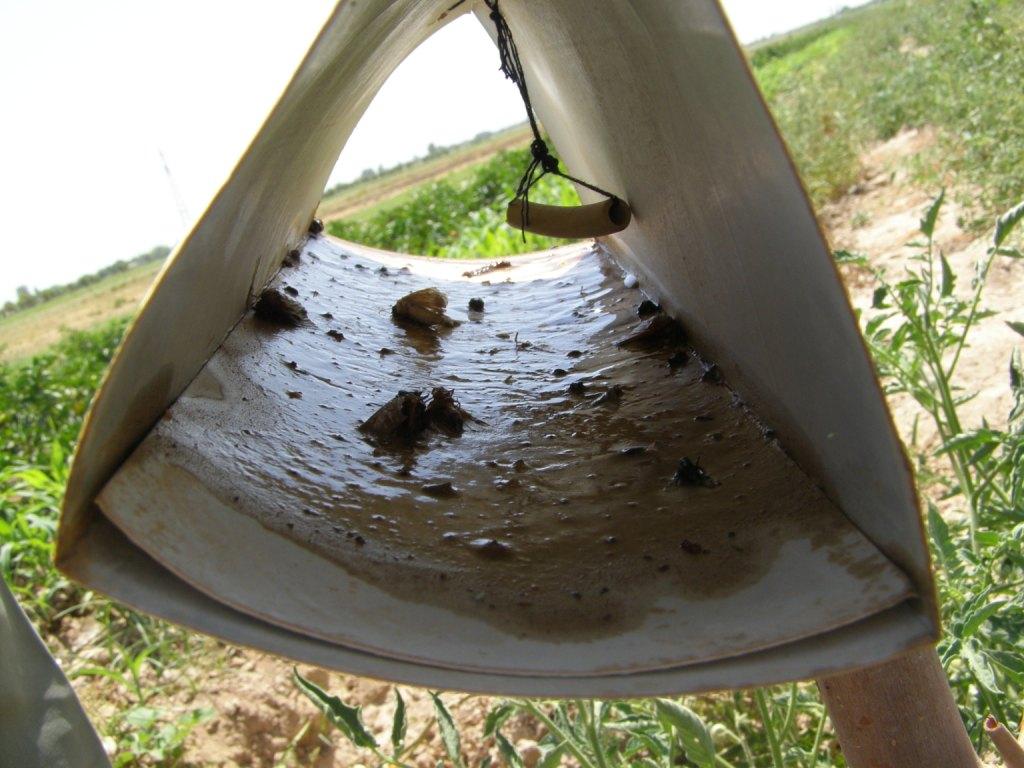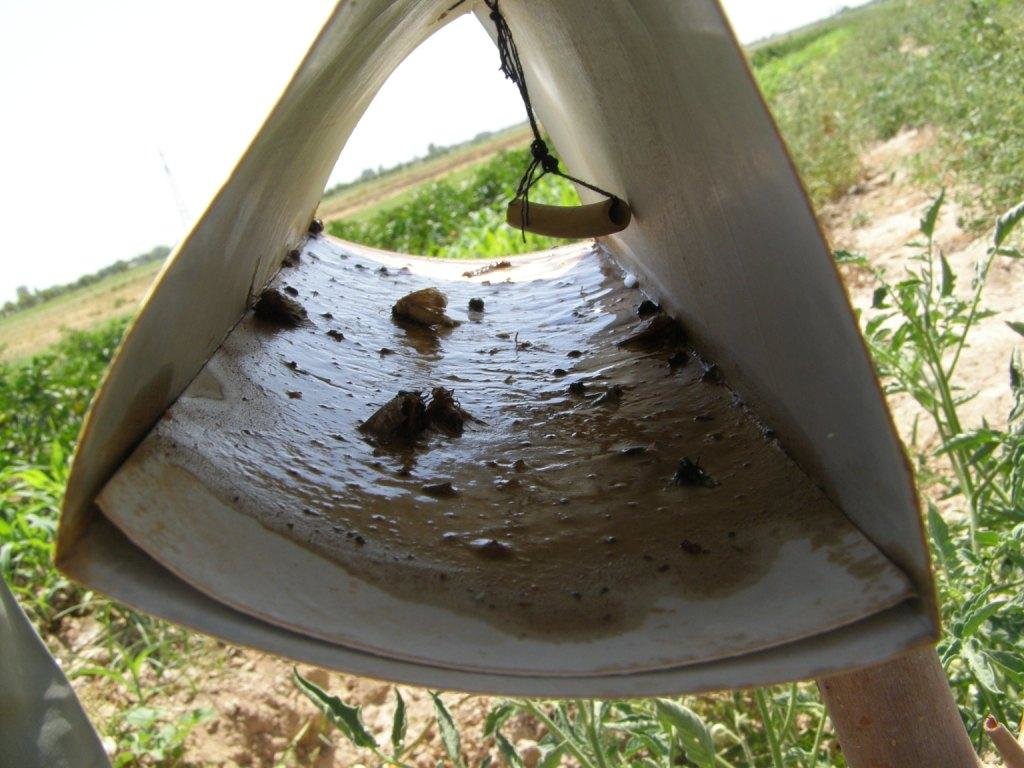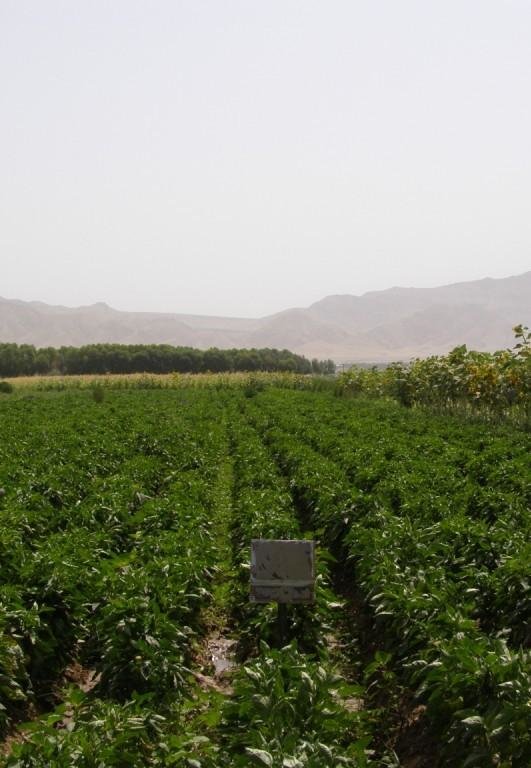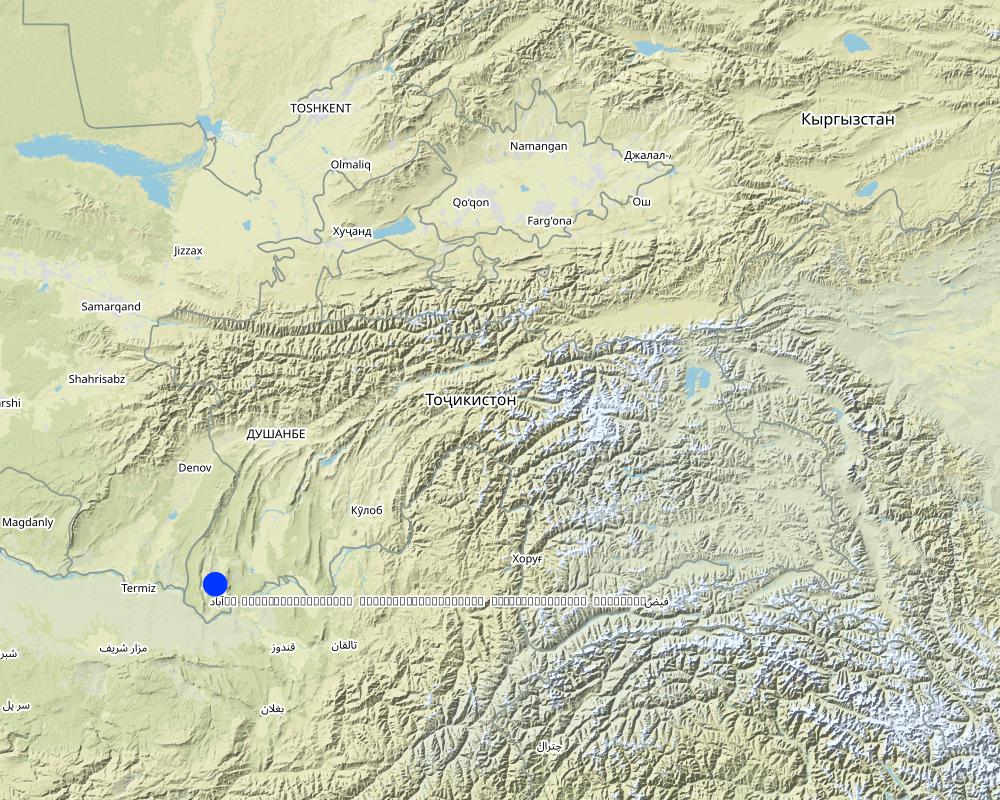Pest management with pheromone insect traps [Tajikistan]
- Creation:
- Update:
- Compiler: Firdavs Faizulloev
- Editor: –
- Reviewers: Alexandra Gavilano, David Streiff, Joana Eichenberger
Tajikistan - Central Asian Countries Initiative for Land Management (CACILM/ИСЦАУЗР)
technologies_1054 - Tajikistan
View sections
Expand all Collapse all1. General information
1.2 Contact details of resource persons and institutions involved in the assessment and documentation of the Technology
SLM specialist:
SLM specialist:
SLM specialist:
Urakov Buran
UNDP
Tajikistan
Name of project which facilitated the documentation/ evaluation of the Technology (if relevant)
Pilot Program for Climate Resilience, Tajikistan (WB / PPCR)Name of the institution(s) which facilitated the documentation/ evaluation of the Technology (if relevant)
United Nations Development Program (United Nations Development Program) - TajikistanName of the institution(s) which facilitated the documentation/ evaluation of the Technology (if relevant)
CDE Centre for Development and Environment (CDE Centre for Development and Environment) - SwitzerlandName of the institution(s) which facilitated the documentation/ evaluation of the Technology (if relevant)
Central Asian Countries Initiative for Sustainable Land Management - Multicountry Capacity Building (CACILM - MCB) - Kyrgyzstan1.3 Conditions regarding the use of data documented through WOCAT
The compiler and key resource person(s) accept the conditions regarding the use of data documented through WOCAT:
Ja
1.5 Reference to Questionnaire(s) on SLM Approaches (documented using WOCAT)
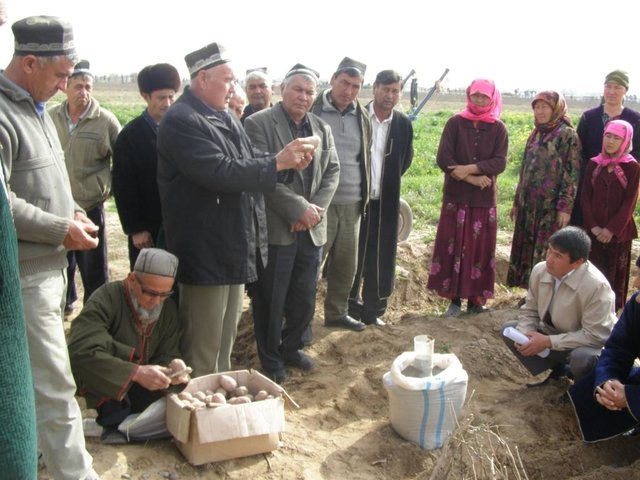
Central Asian Countries Initiative for Sustainable Land Management … [Tajikistan]
Farmer Field Schools (FFS) are held to fill farmer's gaps in knowledge on the use of sustainable agricultural technologies, efficient irrigation water use and prevention of land degradation using trials tailored to local conditions.
- Compiler: Firdavs Faizulloev
2. Description of the SLM Technology
2.1 Short description of the Technology
Definition of the Technology:
Coloured pheromone traps are set up in agricultural fields to attract and eradicate flying insect pests.
2.2 Detailed description of the Technology
Description:
Within the UNDP Farmer Field Schools, farmers were taught about how to use pheromone insect traps to combat insect pests in crop fields. In the past, people used to irrigate their fields in winter with ice-cooled water, or to apply deep ploughing in order to kill pests. According to local people, the winters in the Shaartuz area are getting shorter so it is difficult to apply these practices any more, and they cannot afford to pay for the ploughing devices they need, and therefore pests are spreading.
Purpose of the Technology: The purpose of these traps is to attract flying insects which might constitute crop pests by sending out pheromones and to kill them once in the trap. The main insect pests against which the traps are used include caradrina and other moths from the Noctuidae family, thrips, aphids, whiteflies and mole crickets.
Establishment / maintenance activities and inputs: The trap consists of a wooden body, covered with plastic sheets to protect it from the rain. The exterior is painted in yellow to make it more attractive the insects. Inside the plate, a small tube is fitted which sends out pheromones to attract insects and the floor is covered with a plate covered with a mix of glue and Vaseline to trap the insects. As an alternative to Vaseline, motor oil can also be used. The trap is set up in early May and the sticky plate has to be changed once every two months.
Natural / human environment: This technology is used in fields of tomatoes, watermelon, onion, pumpkin, beans, corn, wheat and sweet pepper. As it is very cheap and simple to establish, there is a strong adoption trend seen among farmers. The pheromone insect traps provide an effective replacement for expensive chemical insecticides. However, the trap is only works for flying insects and methods to combat other arthropod pests still need more testing.
2.3 Photos of the Technology
2.5 Country/ region/ locations where the Technology has been applied and which are covered by this assessment
Country:
Tajikistan
Region/ State/ Province:
Khatlon
Further specification of location:
Kabodion
Specify the spread of the Technology:
- evenly spread over an area
If precise area is not known, indicate approximate area covered:
- 10-100 km2
Comments:
Total area covered by the SLM Technology is 60 km2.
Around 160 farmers are using the technology distributed over 4 Jamoats:
Hudoiqulov Jamoat - 2700 ha,
Nuri Vakhsh Jamoat - 1156 ha,
Telman Jamoat -1450 ha,
Jura Nazarov Jamoat -1200 ha
Map
×2.6 Date of implementation
If precise year is not known, indicate approximate date:
- 10-50 years ago
2.7 Introduction of the Technology
Specify how the Technology was introduced:
- during experiments/ research
3. Classification of the SLM Technology
3.1 Main purpose(s) of the Technology
- reduce cost for inputs
3.2 Current land use type(s) where the Technology is applied

Cropland
- Annual cropping
Annual cropping - Specify crops:
- legumes and pulses - beans
- cereals - wheat (spring)
- vegetables - root vegetables (carrots, onions, beet, other)
- Tomatoes, Pumpkin, Watermelon, Sweet Pepper, Corn
Number of growing seasons per year:
- 1
Specify:
Longest growing period in days: 240Longest growing period from month to month: March-October
Comments:
Major land use problems (land users’ perception): wind erosion, aridity, low soil fertility, increasing impacts of climate change, pests
3.4 Water supply
Water supply for the land on which the Technology is applied:
- mixed rainfed-irrigated
3.5 SLM group to which the Technology belongs
- integrated pest and disease management (incl. organic agriculture)
3.6 SLM measures comprising the Technology

agronomic measures
- A7: Others
Comments:
Main measures: agronomic measures
3.7 Main types of land degradation addressed by the Technology

biological degradation
- Bp: increase of pests/ diseases, loss of predators
Comments:
Main type of degradation addressed: Bp: increase of pests / diseases, loss of predators
Main causes of degradation: soil management (Irrigation with icy water in winter would be required but is not done any longer), change in temperature (warmer winters)
3.8 Prevention, reduction, or restoration of land degradation
Specify the goal of the Technology with regard to land degradation:
- prevent land degradation
Comments:
Main goals: prevention of land degradation
4. Technical specifications, implementation activities, inputs, and costs
4.1 Technical drawing of the Technology
Technical specifications (related to technical drawing):
Technical knowledge required for field staff / advisors: low
Technical knowledge required for land users: low
Main technical functions: control of pests
Agronomic measure: pest control
Material/ species: plastic pheromone traps
Quantity/ density: 4
Remarks: 4 traps per hectare
4.2 General information regarding the calculation of inputs and costs
Specify currency used for cost calculations:
- USD
4.3 Establishment activities
| Activity | Timing (season) | |
|---|---|---|
| 1. | Set up insect trap | early May |
4.4 Costs and inputs needed for establishment
| Specify input | Unit | Quantity | Costs per Unit | Total costs per input | % of costs borne by land users | |
|---|---|---|---|---|---|---|
| Equipment | Buying traps | pieces | 4.0 | 4.0 | 16.0 | 100.0 |
| Total costs for establishment of the Technology | 16.0 | |||||
| Total costs for establishment of the Technology in USD | 16.0 | |||||
Comments:
4 traps per ha
4.5 Maintenance/ recurrent activities
| Activity | Timing/ frequency | |
|---|---|---|
| 1. | Change glue on plate | once every two months |
| 2. | None | None |
4.6 Costs and inputs needed for maintenance/ recurrent activities (per year)
| Specify input | Unit | Quantity | Costs per Unit | Total costs per input | % of costs borne by land users | |
|---|---|---|---|---|---|---|
| Labour | Change glue on plate | - | 1.0 |
Comments:
Machinery/ tools: plastic plates, yellow colour, glue, vaseline, motor oil, pheromone tube
The costs mentioned apply to the set-up of 4 traps per hectare and include all materials used
5. Natural and human environment
5.1 Climate
Annual rainfall
- < 250 mm
- 251-500 mm
- 501-750 mm
- 751-1,000 mm
- 1,001-1,500 mm
- 1,501-2,000 mm
- 2,001-3,000 mm
- 3,001-4,000 mm
- > 4,000 mm
Agro-climatic zone
- arid
Thermal climate class: temperate
5.2 Topography
Slopes on average:
- flat (0-2%)
- gentle (3-5%)
- moderate (6-10%)
- rolling (11-15%)
- hilly (16-30%)
- steep (31-60%)
- very steep (>60%)
Landforms:
- plateau/plains
- ridges
- mountain slopes
- hill slopes
- footslopes
- valley floors
Altitudinal zone:
- 0-100 m a.s.l.
- 101-500 m a.s.l.
- 501-1,000 m a.s.l.
- 1,001-1,500 m a.s.l.
- 1,501-2,000 m a.s.l.
- 2,001-2,500 m a.s.l.
- 2,501-3,000 m a.s.l.
- 3,001-4,000 m a.s.l.
- > 4,000 m a.s.l.
5.3 Soils
Soil depth on average:
- very shallow (0-20 cm)
- shallow (21-50 cm)
- moderately deep (51-80 cm)
- deep (81-120 cm)
- very deep (> 120 cm)
Soil texture (topsoil):
- coarse/ light (sandy)
Topsoil organic matter:
- low (<1%)
If available, attach full soil description or specify the available information, e.g. soil type, soil PH/ acidity, Cation Exchange Capacity, nitrogen, salinity etc.
Soil fertility is very low
Soil drainage / infiltration is good
Soil water storage capacity is very low
5.4 Water availability and quality
Availability of surface water:
poor/ none
Water quality (untreated):
poor drinking water (treatment required)
Comments and further specifications on water quality and quantity:
poor drinking water (treatment required)= groundwater
5.5 Biodiversity
Species diversity:
- low
5.6 Characteristics of land users applying the Technology
Market orientation of production system:
- mixed (subsistence/ commercial)
Off-farm income:
- less than 10% of all income
Individuals or groups:
- individual/ household
Level of mechanization:
- mechanized/ motorized
Gender:
- women
- men
Indicate other relevant characteristics of the land users:
Land users applying the Technology are mainly common / average land users
Population density: 50-100 persons/km2
Annual population growth: 2% - 3%
5.7 Average area of land used by land users applying the Technology
- < 0.5 ha
- 0.5-1 ha
- 1-2 ha
- 2-5 ha
- 5-15 ha
- 15-50 ha
- 50-100 ha
- 100-500 ha
- 500-1,000 ha
- 1,000-10,000 ha
- > 10,000 ha
Is this considered small-, medium- or large-scale (referring to local context)?
- medium-scale
Comments:
Average area of land owned or leased by land users applying the Technology also 50-100 ha
5.8 Land ownership, land use rights, and water use rights
Land ownership:
- state
Land use rights:
- leased
5.9 Access to services and infrastructure
health:
- poor
- moderate
- good
education:
- poor
- moderate
- good
technical assistance:
- poor
- moderate
- good
employment (e.g. off-farm):
- poor
- moderate
- good
markets:
- poor
- moderate
- good
energy:
- poor
- moderate
- good
roads and transport:
- poor
- moderate
- good
drinking water and sanitation:
- poor
- moderate
- good
financial services:
- poor
- moderate
- good
6. Impacts and concluding statements
6.1 On-site impacts the Technology has shown
Socio-economic impacts
Production
risk of production failure
Income and costs
expenses on agricultural inputs
Comments/ specify:
pesticides
Socio-cultural impacts
food security/ self-sufficiency
Livelihood and human well-being
Ecological impacts
Biodiversity: vegetation, animals
pest/ disease control
6.3 Exposure and sensitivity of the Technology to gradual climate change and climate-related extremes/ disasters (as perceived by land users)
Gradual climate change
Gradual climate change
| Season | increase or decrease | How does the Technology cope with it? | |
|---|---|---|---|
| annual temperature | increase | well |
Climate-related extremes (disasters)
Meteorological disasters
| How does the Technology cope with it? | |
|---|---|
| local rainstorm | well |
| local windstorm | not well |
Climatological disasters
| How does the Technology cope with it? | |
|---|---|
| drought | well |
Hydrological disasters
| How does the Technology cope with it? | |
|---|---|
| general (river) flood | well |
Other climate-related consequences
Other climate-related consequences
| How does the Technology cope with it? | |
|---|---|
| reduced growing period | well |
| hail | not well |
Comments:
a cover could be applied to the trap to protect it from hail
6.4 Cost-benefit analysis
How do the benefits compare with the establishment costs (from land users’ perspective)?
Short-term returns:
positive
Long-term returns:
positive
How do the benefits compare with the maintenance/ recurrent costs (from land users' perspective)?
Short-term returns:
very positive
Long-term returns:
very positive
6.5 Adoption of the Technology
- 1-10%
If available, quantify (no. of households and/ or area covered):
160 household in an area of 60 km^2 (density 50-100 persons/km^2)
Of all those who have adopted the Technology, how many did so spontaneously, i.e. without receiving any material incentives/ payments?
- 91-100%
Comments:
100% of land user families have adopted the Technology without any external material support
160 land user families have adopted the Technology without any external material support
Comments on spontaneous adoption: The technology was shown to the farmers in the Farmer Field Schools, and as a result many adopted the techniques and built traps for themselves.
There is a strong trend towards spontaneous adoption of the Technology
6.7 Strengths/ advantages/ opportunities of the Technology
| Strengths/ advantages/ opportunities in the land user’s view |
|---|
| Effective pest control |
| Very cheap and simple to apply technology |
| Strengths/ advantages/ opportunities in the compiler’s or other key resource person’s view |
|---|
|
Biological pest control How can they be sustained / enhanced? Arrange for farmer to farmer visits to disseminate information. |
6.8 Weaknesses/ disadvantages/ risks of the Technology and ways of overcoming them
| Weaknesses/ disadvantages/ risks in the land user’s view | How can they be overcome? |
|---|---|
| The trap only attracts flying insects, but does not help to kill other types of pests | Develop technologies to control caterpillars etc. |
| The small pheromone tube that is used in the setup of the trap is more and more difficult to find in the local chemist shops |
| Weaknesses/ disadvantages/ risks in the compiler’s or other key resource person’s view | How can they be overcome? |
|---|---|
| The trap does not differentiate between flying insects, so it is possible that it will also catch beneficial insects as well as pests. |
7. References and links
7.1 Methods/ sources of information
Links and modules
Expand all Collapse allLinks

Central Asian Countries Initiative for Sustainable Land Management … [Tajikistan]
Farmer Field Schools (FFS) are held to fill farmer's gaps in knowledge on the use of sustainable agricultural technologies, efficient irrigation water use and prevention of land degradation using trials tailored to local conditions.
- Compiler: Firdavs Faizulloev
Modules
No modules


